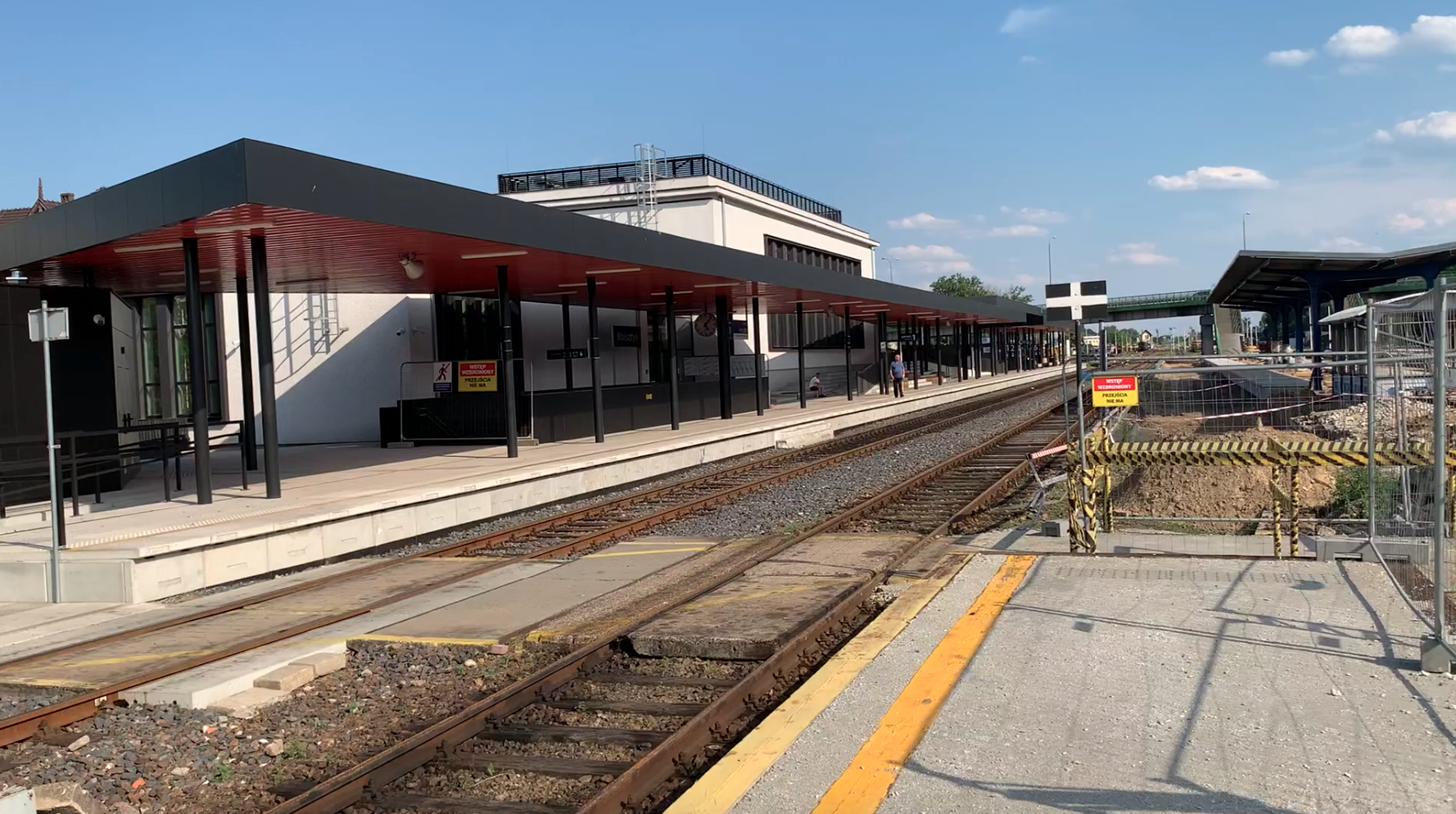Wolsztyn 2022-07-16
Wolsztyn Railway Station.
Geographic coordinates: 52.111N 16.108E. Elevation 61 m.
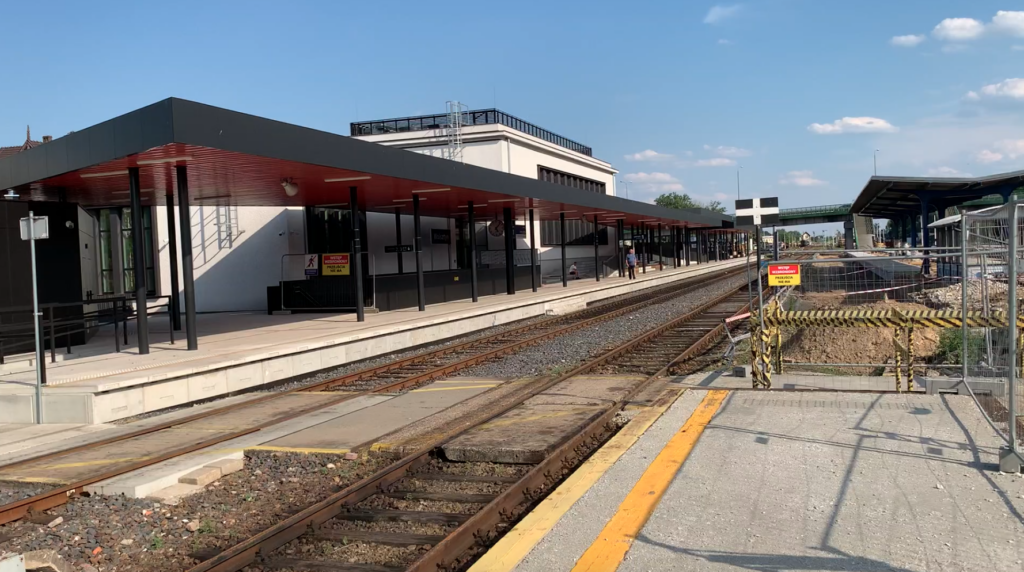
Photo description: The station after renovation. View towards the south-east. The photo was taken from a temporary platform.
The city of Wolsztyn.
Wolsztyn is located in the Wielkopolska Province in Wolsztyn County and is the seat of the commune. The city has 12,767 inhabitants (2021). The area of the city is 4.78 square kilometers. Historically, the city also belongs to Wielkopolska. Wolsztyn lies between two lakes: Biedrzyńskie, Wolsztyńskie and on the Dojca River. It is 75 km from Wolsztyn to Poznań, 61 km to Zielona Góra, 59 km to Leszno, 50 km to Nowa Sól, 375 km to Warsaw.
The settlement was founded in 1285 by the Order of Cistercian Fathers. Wolsztyn obtained city rights before 1424, which were later confirmed in 1458. Wolsztyn was a private town. Cloth and weaving developed here, based on wool and linen. Over the centuries, the town was visited by numerous natural disasters: fires and epidemics.
In 1793, together with the second partition of Poland, the town of Wolsztyn fell to the Prussian partition. The Prussians Germanized the name Wolsztyn – Wollstein. Prussian populations quickly flowed into the town. Within three years, the Prussian population outnumbered the Polish population three times. Poles were systematically and brutally persecuted. Poles often lost their property and were expelled to the countryside. This was the case until the Great World War. In 1919, as a result of the Greater Poland Uprising, Wolsztyn returned to the borders of the Reborn Polish Republic. Although the border with the Germans was only about 10 km away. And again, the stupid Germans started the Second World War. The Polish population was arrested or deported to the General Government. There were labor camps and prisoner of war camps in the city. On January 26, 1945, Soviet troops entered Wolsztyn. And again Wolsztyn returned to Poland, this time communist Poland.
Railway lines in the Wolsztyn area.
Railway line No. 357 Sulechów – Wolsztyn – Luboń near Poznań.
Railway line No. 357 is 112.182 km long. Single-track, non-electrified, with a maximum speed of up to 110 km/h. The route was built in stages from 1904 to 1909 and was also put into service in stages. The Sulechów – Wolsztyn – Luboń route in 1948 had No. 319, and in 1988, No. 332.
The Sulechów – Wolsztyn section lost its importance the fastest. It was 38 km long. In 1994, rail traffic was suspended on it. In 2015, the tracks on the Sulechów – Powodowo section (the first station from Wolsztyn) were dismantled. The tracks remain in several railway-road crossings. Among others, through DW No. 314, Smolno Wielkie, Sulechów (three crossings). Some crossings still have St. Andrew’s Crosses. Some station buildings remain: Żodyń, Kopnica, Kargowa, Smolno Wielkie (there are shaped semaphores), Okunin (the station is visible from DW No. 304). The steel Kopnica railway bridge on the Northern Obra Canal, the bridge on the Dźwiński Canal, the bridge on the Obrzyca Canal, the bridge on the Obra Canal. The tracks remain in the vicinity of Kargowa. The remains of the tracks are in Sulechów on Brzozowa Street, just before the station. On March 14, 2011, the renovation of the Wolsztyn – Luboń section, 65 km long, began. The tracks were replaced on a total length of 73 km. New platforms were built at the stations: Tłoki, Rakoniewice, Ruchocice, Grąblewo (new stop), Kotowo, Granowo, Strykowo, Stęszew, Trzebaw, Szreniawa and Wiry. Rail-road crossings were modernised: DK No. 32 (3 crossings), Grodzisk Wielkopolski (9 crossings), Granowo, Stęszew, Szreniawa. New railway traffic control devices were installed. The cost of modernisation amounted to PLN 84 million. Passenger trains (railbuses and DMUs) run on this route at a maximum speed of 110 km/h. The route is operated by Koleje Wielkopolskie.
Railway line No. 359 Leszno – Wolsztyn – Zbąszyn.
Railway line No. 359 Leszno – Wolsztyn – Zbąszyn in 1948, had No. 320, and in 1988 had No. 328. The line is 69.650 km long, and is in use. It was built in 1886 and its task was to shorten the route from Upper Silesia to Szczecin Pomerania, bypassing Poznań. It was treated by the Prussians as first-rate and was built with good parameters. In the future, it was planned to rebuild the second track. The line runs through the following stations: Wilkowice, Krzycko Wielkie, Włoszakowice, Boszkowo (PO), Starkowo (PO), Błotnica, Perkowo (PO), Nowa Wieś Mochy, Nowy Solec (PO), Wroniawy (PO), Widzim (PO), Wolsztyn, Tuchorza, Belęcin, Stefanowo.
Interesting facts include the shape semaphores installed on the route. In the town of Nowa Wieś Mochy there are barriers at the railway crossing, metal with a shutter for farm animals such as sheep and goats, so that they do not enter the tracks. The route is used for passenger and freight transport. Coal is mainly transported. There is a railway memorial room in Stefanów.
Railway line No. 371 Wolsztyn – Nowa Sól – Żagań.
Railway line No. 371 Wolsztyn – Żagań is a single-track, non-electrified line of local importance, with a length of 92.620 km. Currently, only the Wolsztyn – Krzyż Rudno section is in use, with a length of 17.270 km and a special procedure. On the section in use, the maximum speed is 100 km/h.
The route was put into use in stages: 1889, Nowa Sól – Kożuchów, 1890, Kożuchów – Żagań, 1906 – 1907, Wolsztyn – Konotop and Nowa Sól – Otyń, 1908, Konotop – Otyń.
PKP took over the line in 1945, but due to war damage, traffic was restored only in 1955. In 1993, passenger traffic was suspended, and in 1997 freight traffic. On the Sławocin – Otyń and Nowa Sól – Stypułów sections, bicycle paths were built, in 2020. As recently as 2004–2005, tourist trains ran on the Wolsztyn–Konotop route.
The line ran through: Kłębowo, Świętno, Krzyż Rudno, Kolsko, Konotop, Lubicin, Lipiny, Stanów, Otyń, Nowa Sól, Ciepielów, Kożuchów, Stypułów, Chotków, Jelenin, Stara Kopernia, Bożnów.
Description of the trail. The trail crosses the Northern Obra Canal, the Middle Obra Canal, then through DW No. 315, DW No. 314, the Southern Obra Canal (Świętno railway bridge), Kolsko with a railway station at the station, Konotop with a railway station at the station, a ramp and a water tower, DW No. 278, Lubicin with a railway station at the station, under the viaduct of the DW No. 315 road, Lipiny with a railway station at the station, through DW No. 315, a historic brick viaduct over the local asphalt road, Stanów with the ruins of station buildings, Stanów – an iron railway bridge over the Odra (currently a pedestrian and bicycle path), Otyń – an iron bridge over the “Nadodrzanki” railway route, Nowa Sól, then under the S3 expressway, Kożuchów with station buildings, through DW No. 296 three times, Jelenin – the remains of the station, again through DW No. 296, Stara Kopernia – remains of the station, Under the bridge of DK No. 12, before the bridge over the Bóbr river the line will join the Głogów – Żagań route (There was a branch post and a safety rib here).
In 1948, the line had No. 319a/322/319a/323, but the bridge over the Odra was destroyed. Therefore, from Konotop trains could only go to Sulechów. On the other hand, from Nowa Sól to Głogów or Sulechów. In 1988, the line on the Wolsztyn – Nowa Sól section had No. 348, and on the Kolsko – Konotop section it shared the route with the No. 347 Głogów – Sulechów line. On the Nowa Sól – Żagań section it had No. 352.
Wolsztyn railway station.
The Wolsztyn railway station was officially opened in Prussian times on June 1, 1886. The first trains ran from Zbąszyń to Wolsztyn. In 1896, the route was extended from Wolsztyn to Leszno. In 1898, railway lines were launched east to Grodzisk Wielkopolski and west to Sulechów. In 1908, a railway line to Nowa Sól was opened. Wolsztyn was a five-way junction station. Currently, two of these directions are out of service. A siding also led from Wolsztyn station to a furniture factory, which was liquidated.
Currently (2022), Wolsztyn station is undergoing a general renovation. First, the station was renovated, which became the city’s showcase. Three platforms were completely rebuilt. Platform 1 is single-edged and lies on the station side. Platforms 2, 3 are island and double-edged.
The first station was built in 1895. It was a simple building made of clinker brick, with a gable roof covered with tiles. In 1919, Wolsztyn station found itself within the borders of the Reborn Republic of Poland. Polish railway workers soon arrived here. Rail traffic was maintained to Zbąszyń, Leszno and Grodzisk Wielkopolski, i.e. with all Polish cities.
However, the stupid Germans started the Second World War. On September 1, 1939, as a result of a German attack, the station burned down. Its function was taken over by a barrack and a wooden building of the railway expedition. As a result of the end of World War II and the change of borders, Wolsztyn found itself far from the border with Germany. Trains again began to run westwards to Sulechów and Nowa Sól.
The locomotive shed was built in 1907. Due to the spatial layout of the city, it was placed in the south-eastern edge of the station. The entire local traction was serviced by steam locomotives from the Wolsztyn locomotive shed.
In 1945, the retreating Germans left only one Pd5 type steam locomotive in Wolsztyn. Soon, as a result of war repairs, more steam locomotives arrived in Wolsztyn; TKi3, Pd5, OKi2, TKt1. In the following years, new locomotives built in Poland were delivered to Wolsztyn: Pt47 (1948), Ty45 (1945), Ty51 (1953), Ol49 (1951).
In 1961, a new modernist style station was built in Wolsztyn; spacious, glazed and functional. The project was prepared in 1957 by the architect Mr. Kazimierz Serowski.
In the period 1945-1993 many freight trains passed through Wolsztyn, mainly with hard coal, agricultural products, machines and devices. There were a lot of wax trains, echelons, which belonged to the CCCP, because in the Lubuskie Province the Soviet troops occupied many garrisons. Heavy steam locomotives of the Ty2, Ty43 and Ty45 types were used for traction of these trains. In the 70s, diesel locomotives of the ST43 and ST44 types began to be used. In passenger traffic, express Prussian steam locomotives Pd5, Ok1 and American Tr203 were used, later replaced by Ol49 steam locomotives, which were withdrawn from electrified routes.
In May 1993, the Lubuska Regional Railway launched rail connections on the railway line to Nowa Sól and Sulechów. The problem, however, was that PKP was a monopolist and the carrier’s operations were closed in 1994. After 1994, the number of passenger rail connections decreased. Passengers changed to their own cars or private carriers’ buses. The network of connections offered also decreased.
Only since 2010 has the transport situation begun to improve. New railbuses and DMUs appeared. The number of passengers transported slowly increased. Renovations were started at nearby stations and passenger stops, by rebuilding platforms, repairing tracks and rail-road crossings.
In 2019, Wolsztyn station served about 1,200 people per day. In the period 2020-2023, a thorough reconstruction of the platforms, track layout and traffic control system was carried out. In 2018, the warehouse located near the station was dismantled. A bus station was built in this place.
The platforms are connected by a tunnel. A characteristic feature of the tunnel are the visible steel, riveted ceiling structures on which the tracks rest. From Platforms 2, 3 it is possible to climb the stairs to the viaduct, through which Aleja Niepodległości Street (DW No. 32) runs. On the north-west side, near the station, there is a footbridge over the pedestrian tracks. Due to its poor technical condition, the footbridge is out of service. All rails at the station were mounted on wooden sleepers or old-type concrete sleepers. However, due to the ongoing track renovation, the new sleepers will be pre-stressed concrete. Train traffic is managed by two signal boxes: “Wl” and “Wl1”, which have centralized mechanical devices with shape signaling and several shunting shields in the station. The signal boxes also service the barriers at the level crossings; “Wl” the crossing on Fabryczna Street (DW Nr 305, by the Lokomotywownia), “Wl1” the crossing on 5 Stycznia Street.
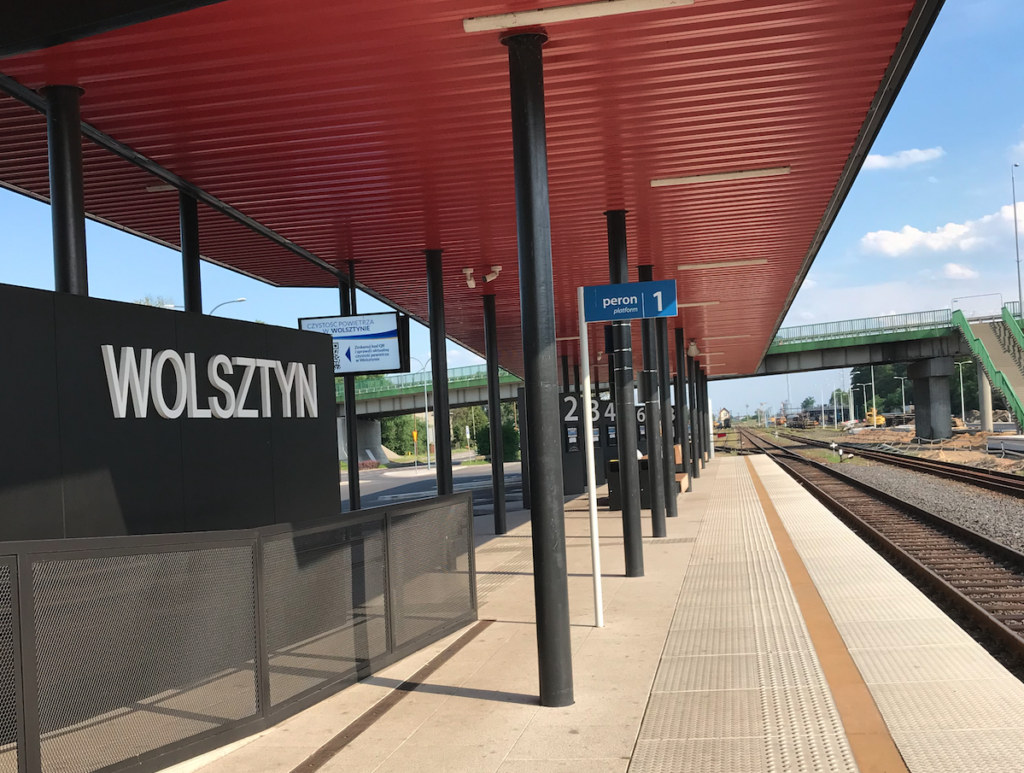
Photo description: New Platform 1, which also houses the bus station. View towards the southeast. The viaduct visible is Aleja Niepodległości Street (DW Nr 32).
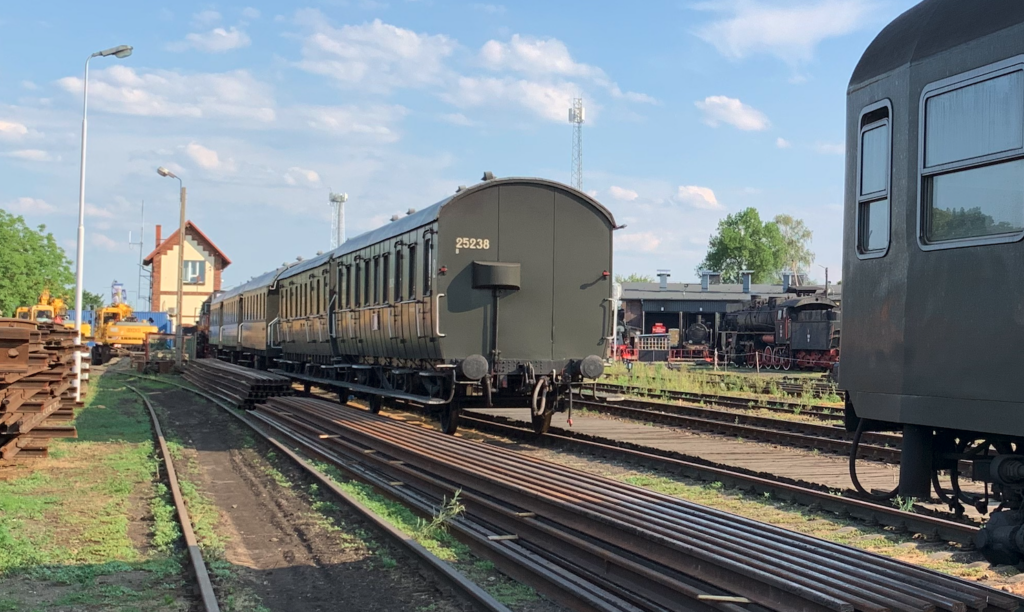
Photo description: The photo shows: “Wl” Signal Room, Retro Train and Locomotive Shed.
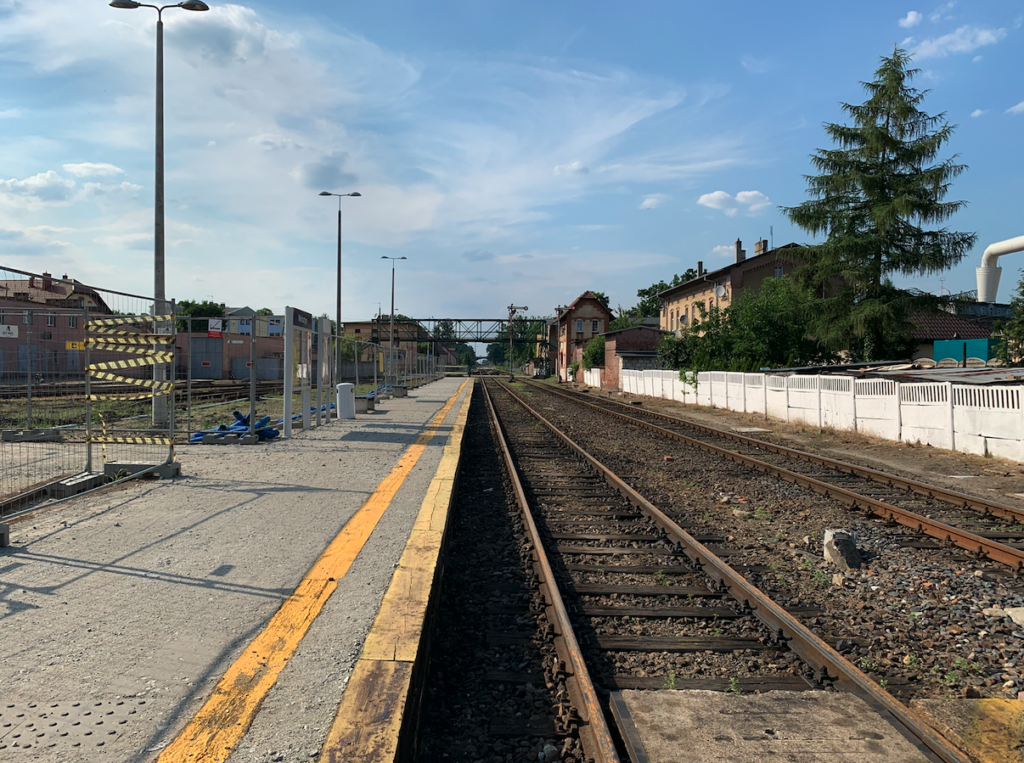
Photo description: The photo shows: Temporary platform, Shape semaphores, “Wl1” signal box, Inactive footbridge over the tracks at 5 Stycznia Street.
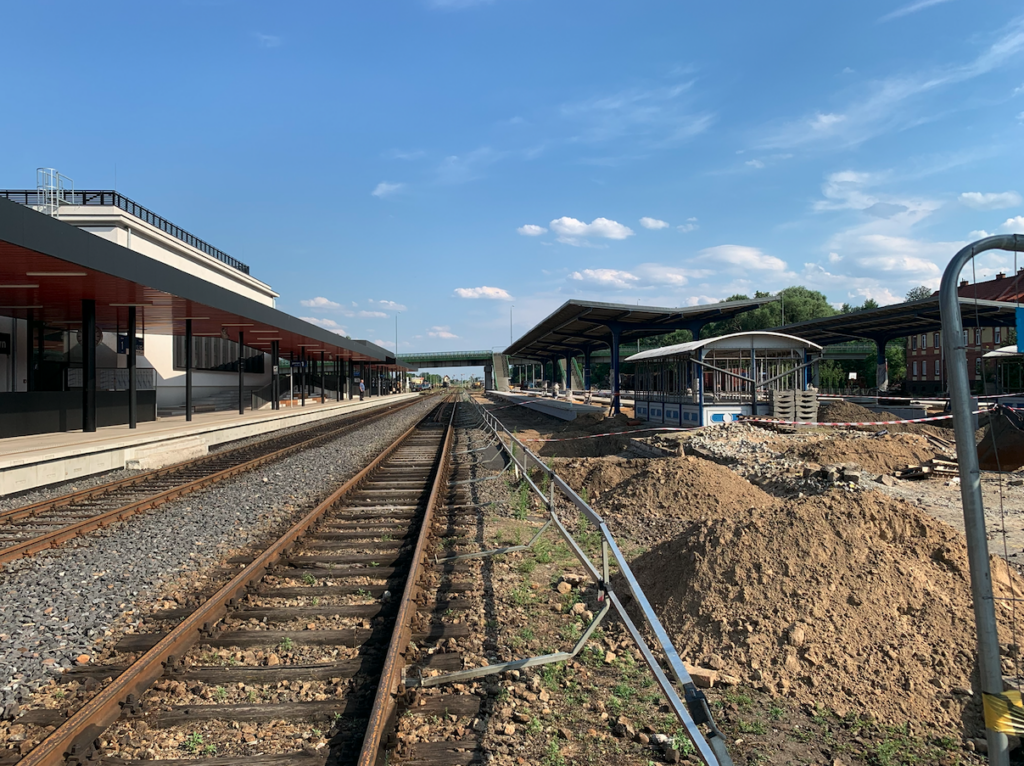
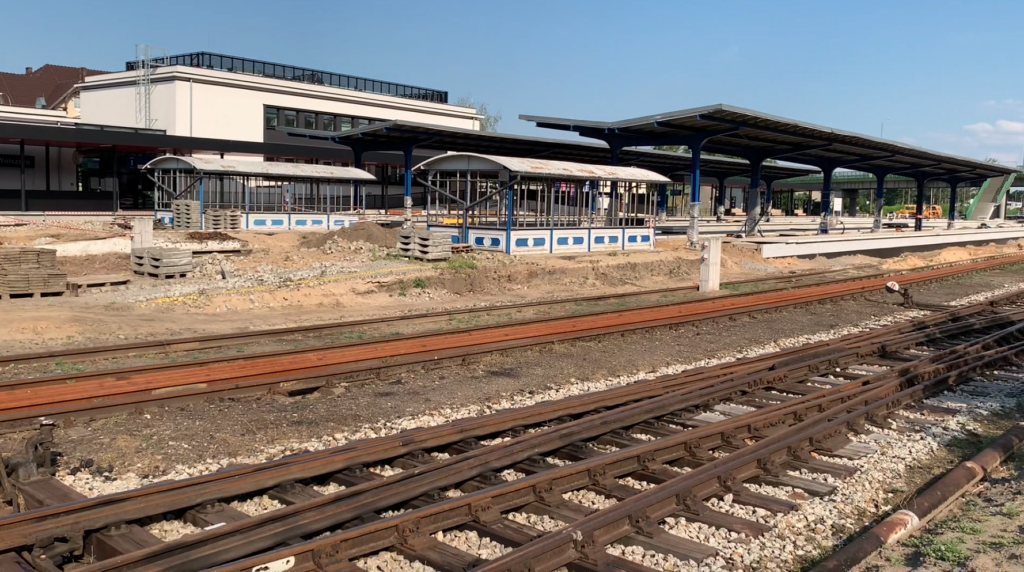
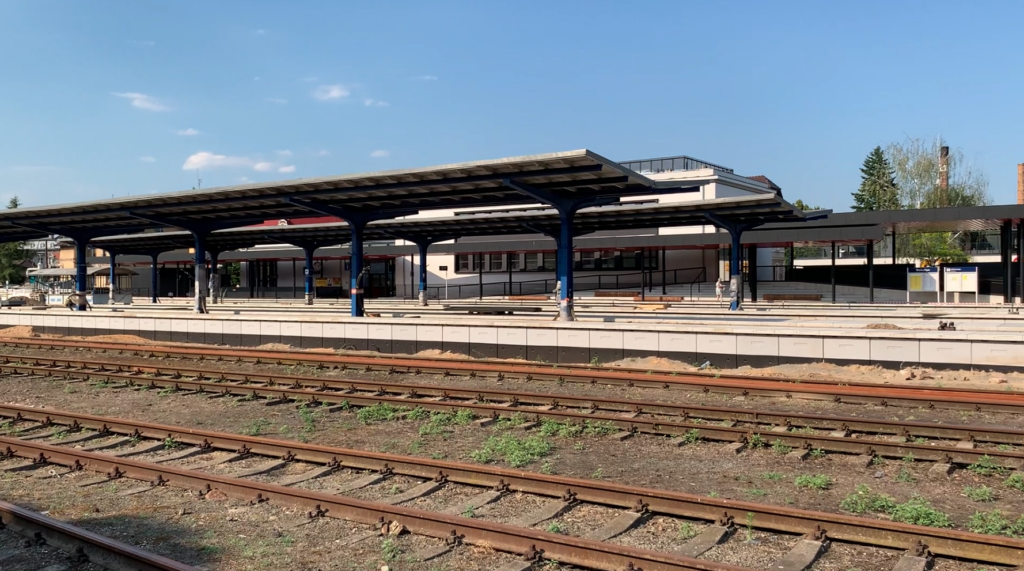
Wolsztyn Station. 2022.
In the period 2019-2022, the station in Wolsztyn was completely rebuilt. Inside, there is a cinema, space for a restaurant, a press room, and on the first floor, office space for rent. The station has been deprived of architectural barriers for people with limited mobility, installing, among other things, elevators and ramps, which are also convenient for travelers with large luggage. There is a modern railway information desk, benches for travelers, modern LED lighting. As part of the safety of travelers and the facility, a monitoring system has been installed. From the side of ul. 5 Stycznia, a public station square with a clock was designed in front of the station. A 24-hour toilet and bicycle parking are located here.
The building was so well-received that in 2022, it received the architectural award of the Wielkopolska province in the public utility building category. The station renovation project was prepared by the PL.architekci team: Bartłomiej Bajon, Katarzyna Cynka-Bajon and Bartosz Stanek.
Wolsztyn Locomotive Depot.
The Wolsztyn Locomotive Depot on Fabryczna Street is one of the few active facilities of this type in Poland. Similar active facilities can be found in; Jaworzyna Śląska, Chabówka, Kościerzyna. Each of these facilities has its own specificity and is worth visiting. There are even smaller locomotive depots on narrow-gauge railways, for example in Sochaczew.
The locomotive depot was built in 1907. Due to the spatial layout of the city, it was placed on the south-eastern edge of the station.
In Wolsztyn, you can watch the work of railway workers. You can see up close how a steam locomotive is watered and coaled or you can take a ride on the Retro train. On weekdays, they run on the route to Leszno, on Saturdays to Poznań. There are also special courses. Steam locomotives are stationed in Wolsztyn: Ok1, Ok22, Pm36. There are also historic and used wagons. Every year at the turn of April and May a “Steam Locomotive Parade” takes place. At that time steam locomotives from abroad also come to Wolsztyn.
Written by Karol Placha Hetman
